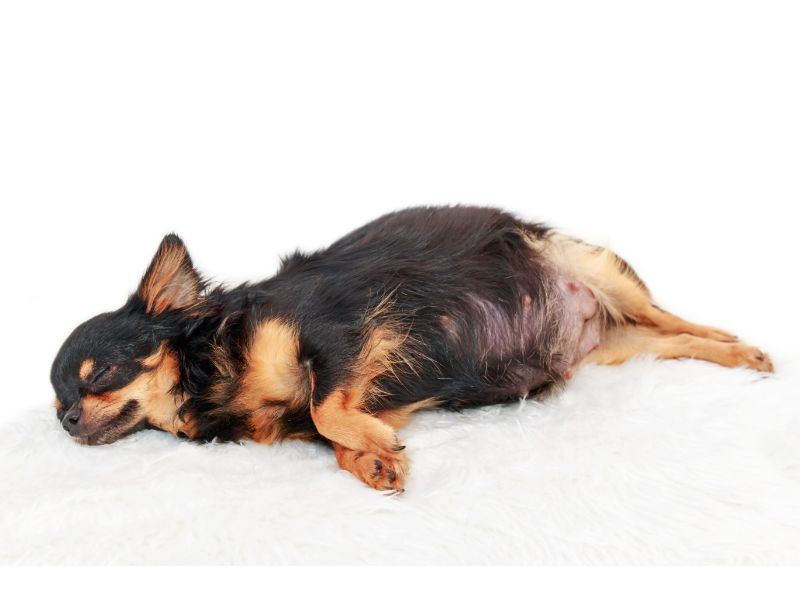Yes, a pregnant dog can jump around, but it is not recommended as it may pose risks to her and her unborn puppies. Pregnancy is a crucial time for a dog, and it is essential to ensure her health and safety.
- Understanding The Physical Changes During Pregnancy
- Assessing The Risks And Benefits Of Jumping During Pregnancy
- Guidelines For Exercise And Jumping During Pregnancy
- Observing Signs Of Discomfort Or Complications
- Providing A Safe And Supportive Environment For A Pregnant Dog
- Frequently Asked Questions On Can A Pregnant Dog Jump Around
- Conclusion
While it is possible for a pregnant dog to jump around, it is not advisable as it may jeopardize her well-being and that of her unborn puppies. Pregnancy brings significant changes to a dog’s body, including increased weight and changes in balance.
Jumping can lead to injuries or complications like placental detachment or premature labour. Therefore, it is crucial for dog owners to provide a safe and secure environment for their pregnant dogs, limiting activities that may put unnecessary strain on the dog’s body. By taking preventive measures, we can ensure the health and well-being of both the mother and her puppies during this crucial period.
Understanding The Physical Changes During Pregnancy
During pregnancy, a dog’s body goes through numerous physical changes to support the growth and development of her unborn puppies. These changes are necessary to ensure a successful pregnancy and prepare the dog for motherhood. In this section, we will explore how pregnancy affects a dog’s body, the role of hormones in pregnancy, and the changes in weight and size that occur during this crucial period.
How Pregnancy Affects A Dog’s Body
Pregnancy brings about many changes in a dog’s body. As the puppies develop and grow inside her, the dog’s uterus expands to accommodate them. This leads to an increase in the size and weight of the abdomen, making it more challenging for the dog to move around comfortably. Additionally, the ligaments supporting the dog’s pelvis and spine become more relaxed, allowing for easier passage during the birthing process.
The Role Of Hormones In Pregnancy
Hormones play a vital role in a dog’s pregnancy. The primary hormone responsible for initiating and maintaining pregnancy is progesterone. Progesterone is produced by the dog’s ovaries and helps prepare the uterus for implantation and the development of the puppies. As the pregnancy progresses, other hormones, such as estrogen and relaxin, come into play. Estrogen helps regulate the growth of the puppies, while relaxin helps relax the dog’s ligaments, preparing her body for the birthing process.
Changes In Weight And Size
As the pregnancy progresses, the dog will experience changes in weight and size. A pregnant dog may gain anywhere from 15% to 25% of her pre-pregnancy weight, depending on the number of puppies she is carrying. This weight gain is primarily due to the growth of the puppies, the development of the mammary glands, and an increase in blood volume to support the growing fetuses. The dog’s abdomen will also visibly enlarge as the puppies grow, making her appear bulkier and rounder.
It is important to note that while these changes are normal during pregnancy, they can affect a dog’s mobility and ability to jump around. The extra weight and size can make it physically challenging for her to engage in vigorous activities such as jumping. It is crucial to provide a safe and comfortable environment for a pregnant dog, ensuring she has access to soft bedding and avoiding activities that could potentially harm her or the developing puppies.
Assessing The Risks And Benefits Of Jumping During Pregnancy
When it comes to taking care of a pregnant dog, it’s important to understand the risks and benefits associated with their physical activities. Jumping, in particular, is a topic of concern for many pet owners. In this article, we will dive into whether jumping can harm the developing puppies, the potential risks for the pregnant dog, and the benefits of physical activity during pregnancy.
Can Jumping Harm The Developing Puppies?
During pregnancy, a dog’s body undergoes significant changes to support the development of her puppies. While occasional jumping may not cause harm, it is crucial to be aware of the potential risks it may pose. Dogs that jump excessively or from heights may put extra strain on their bodies, increasing the risk of injury or trauma to the developing puppies.
Potential Risks For The Pregnant Dog
Jumping during pregnancy can also pose risks to the pregnant dog herself. The added weight and strain on her joints and ligaments may lead to sprains, strains, or even fractures. Additionally, the impact from jumping can jolt her body, potentially causing premature labour or complications during delivery. Therefore, it is essential to monitor and regulate the dog’s physical activities to minimize such risks.
Benefits Of Physical Activity During Pregnancy
Despite the risks associated with jumping, physical activity during pregnancy offers numerous benefits for both the pregnant dog and her puppies. Regular exercise helps to maintain muscle tone, promote circulation, and prevent weight gain, all of which contribute to a healthier pregnancy. Moreover, physical activity can enhance the dog’s mental well-being, reducing stress and boredom.
That said, it is important to note that the type and intensity of exercise should be appropriate for the dog’s individual needs and stage of pregnancy. Consultation with a veterinarian is crucial to create a tailored exercise plan that considers the breed, age, health condition, and any factors that may affect the dog’s pregnancy.
Guidelines For Exercise And Jumping During Pregnancy
Pregnancy is a delicate time for any dog, requiring special care and attention. When it comes to exercise and jumping, pregnant dogs need to be handled with caution to ensure the safety of both the mother and her growing puppies. This article will provide you with essential guidelines on exercise and jumping during pregnancy, covering topics such as consultation with a veterinarian, suitable types of exercise, and modifications and limitations for jumping activities.
Consultation With A Veterinarian
Before starting any exercise or jumping routine with your pregnant dog, it is crucial to consult with a veterinarian. A professional evaluation will help determine if the mother is healthy enough for physical activity and jumping. A veterinarian will consider factors such as the dog’s age, breed, overall health, and any previous pregnancy complications. By obtaining professional advice, you can ensure that your pregnant dog’s exercise routine is tailored to her specific needs.
Types Of Exercise Suitable For Pregnant Dogs
While jumping may need to be limited, there are still plenty of exercises that pregnant dogs can safely participate in. These low-impact activities help maintain muscle tone, promote circulation, and prevent excess weight gain without putting too much stress on the mother’s body. Some suitable types of exercise for pregnant dogs include:
- Walking: A daily walk in a safe environment, such as a park or neighbourhood, can provide gentle exercise and mental stimulation for the pregnant dog.
- Swimming: Swimming is an excellent low-impact exercise for pregnant dogs, as it helps support the weight of the belly while increasing cardiovascular fitness.
- Light Play: Engaging in light play sessions, such as gentle fetch or tug-of-war, can help maintain muscle tone without placing excessive strain on the mother’s body.
- Canine Prenatal Classes: Canine prenatal classes, specifically designed for pregnant dogs, provide gentle exercises, stretching, and socialization opportunities under professional supervision.
Modifications And Limitations For Jumping Activities
Jumping activities should be approached with caution during pregnancy to avoid any potential harm to the mother or developing puppies. While a pregnant dog may instinctively jump or hop on occasion, it is essential to minimize these actions. Here are some modifications and limitations to consider:
- Avoid High Jumps: Pregnant dogs should avoid high jumps, such as leaping onto furniture or jumping over obstacles, as these activities could result in abdominal trauma.
- Steer Clear of Strenuous Movements: Activities that involve sudden stops, twists, or changes in direction should be avoided to prevent strain on the mother’s joints and ligaments.
- Use Ramps or Low Platforms: If your pregnant dog needs to access elevated surfaces, consider using ramps or low platforms to minimize the need for jumping.
- Provide Ample Support: Ensure that your pregnant dog always has a stable and secure surface to land on when jumping or hopping.
By following these guidelines for exercise and jumping during pregnancy, you can provide your pregnant dog with the right amount of physical activity while minimizing the risks. Remember, each dog is unique, so always consult with a veterinarian for personalized advice based on your dog’s specific needs and circumstances.
Observing Signs Of Discomfort Or Complications
As responsible pet owners, it is important to closely observe our pregnant dogs for any signs of discomfort or complications. While it’s natural for expectant mothers to engage in regular physical activity, such as walking or running, jumping can be particularly strenuous for them. In this section, we will delve into indications that jumping may be too strenuous, common complications during pregnancy, and when it is essential to seek veterinary assistance.
Indications That Jumping May Be Too Strenuous
Jumping entails bursts of high impact and can potentially strain a pregnant dog’s joints and ligaments. It is crucial to watch out for signs that jumping may be causing discomfort or placing undue stress on their bodies. Some key indications include:
- Reluctance or hesitation to jump
- Painful or stiff movements after jumping
- Limping or favoring a particular leg
- Whining or vocalizing during or after jumping
If you notice any of these signs, it is advisable to limit or prohibit jumping altogether. Instead, provide alternative exercises and activities that are more gentle on their bodies, such as short walks or interactive play.
Common Complications During Pregnancy
Just like human pregnancies, canine pregnancies may come with their share of complications. While most pregnancies progress smoothly, it is important to be aware of potential issues that may arise. Some common complications during dog pregnancy include:
- Miscarriage: Though rare, miscarriages can occur during any stage of pregnancy. Signs of miscarriage may include significant bleeding, loss of appetite, or sudden behavioural changes.
- Preeclampsia: This condition, characterized by high blood pressure, can affect pregnant dogs as well. Symptoms of preeclampsia include swelling in the face or limbs, excessive thirst, and weight loss.
- Pyometra: Pyometra is a uterine infection that can occur in unspayed dogs. It is crucial to monitor for symptoms such as vaginal discharge, fever, excessive thirst, and lethargy.
- Dystocia: Dystocia refers to difficulties during labour and delivery. If you observe prolonged contractions, restlessness, or the absence of puppies after an extended period of time, it is essential to seek immediate veterinary assistance.
Seeking Veterinary Assistance When Necessary
During a dog’s pregnancy, it is vital to maintain regular visits with a trusted veterinarian. However, there are instances where immediate veterinary assistance is warranted. If you notice any of the following signs, seeking prompt, professional advice is highly recommended:
| Signs that require veterinary attention |
|---|
| Bleeding, especially copious or continuous |
| Severe abdominal pain or discomfort |
| Prolonged contractions with no delivery progress |
| Absence of puppies after a prolonged period (over 2 hours) |
Remember, your veterinarian is the best resource when it comes to ensuring the well-being of your pregnant dog. Prompt attention and proper care can significantly contribute to a healthy and successful pregnancy.
Providing A Safe And Supportive Environment For A Pregnant Dog
As a responsible pet owner, it’s essential to ensure a safe and supportive environment for your pregnant dog. During this delicate time, making adjustments to the living space, ensuring comfort and relaxation, and considering dietary needs can greatly contribute to the overall well-being of your furry friend. Let’s take a closer look at each of these aspects to help you provide the best care possible.
Adjustments To The Living Space
Creating a suitable living space for your pregnant dog is crucial for her safety and comfort. Here are a few adjustments you can make:
- Provide a clean and spacious whelping area where she can give birth and nurse her puppies.
- Make sure the area is draft-free and well-insulated to maintain a stable temperature.
- Set up a cosy and comfortable bed for your pregnant dog to rest and relax.
- Ensure there are no potential hazards, such as sharp objects or toxic substances in her surroundings.
Ensuring Comfort And Relaxation
Creating a calm and stress-free environment is vital for a pregnant dog’s well-being. Here are a few ways you can ensure her comfort and relaxation:
- Provide plenty of soft blankets or bedding material for her to nest and make herself comfortable.
- Offer toys and chew treats to keep her mentally stimulated and distracted.
- Minimize loud noises or sudden disturbances that could cause stress or anxiety.
- Give her ample opportunity for daily exercise and gentle walks to keep her physically active and prevent boredom.
Dietary Considerations For A Pregnant Dog
Proper nutrition plays a crucial role in supporting the health of pregnant dogs. Consider the following dietary considerations:
- Consult with your veterinarian to determine the appropriate diet for your pregnant dog.
- Choose a high-quality, balanced dog food specifically formulated for pregnant or nursing dogs.
- Increase the frequency and portion sizes of meals to accommodate her growing nutritional needs.
- Supplement her diet with essential vitamins and minerals, such as calcium, to support the healthy development of her puppies.
- Ensure she always has access to fresh, clean water to stay hydrated.
Frequently Asked Questions On Can A Pregnant Dog Jump Around
Can A Pregnant Dog Jump Around?
Yes, pregnant dogs can jump around, but it is not recommended. Jumping and vigorous exercise can put a strain on the pregnant dog’s body and may increase the risk of complications. It’s best to provide a safe and calm environment for the pregnant dog during this time.
Conclusion
To summarize, it is important to consider the health and safety of a pregnant dog when it comes to jumping around. Although jumping may not pose an immediate danger, it is advisable to limit strenuous activities to protect the wellbeing of both the mother and her puppies.
Consulting with a veterinarian is always the best course of action to ensure the best care for your pregnant dog.




